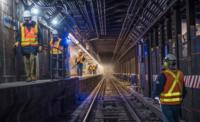Thousands of New Yorkers were dreading the anticipated shutdown of a crucial subway link between Brooklyn and Manhattan for 18 months starting in spring 2019. But the Canarsie Tunnel carrying the L subway line had been heavily damaged by Superstorm Sandy.
Gov. Andrew Cuomo (D), aggressively pursuing a legacy of infrastructure accomplishments, scrapped the original plan by the New York Metropolitan Transportation Authority (MTA) and called on consultants and professors from Columbia and Cornell universities to brainstorm an alternative.
The team offered ideas that included fiber-reinforced polymers (FRP) and new cabling to repair the damaged tunnel. Then Jamey Barbas, a New York infrastructure veteran whose many roles include project director of the New NY Bridge Project for the New York State Thruway Authority, tied it all together.
“Jamey’s contribution of the most robust structural FRP benchwall system critically and significantly enhanced the schedule and cost benefits and further reduced the major service interruptions,” says Mary Boyce, dean of Columbia's School of Engineering, one of Cuomo's lead academic advisers.
Crews with Judlau Contracting in joint venture with TC Electric in April 2020 completed—at least three months early—a $477-million contract to rehabilitate the Canarsie Tunnel.
The original plan was to tear out the benchwalls, which protrude from the sides of the tunnel and allow for emergency evacuations of trains, and replace them. Instead, crews encased vulnerable sections in FRP and installed new fireproof cables on a rack above them. The old cables had been encased in the benchwalls for fire protection. Crews also installed a sensor system on the benchwalls to monitor for further decay.
“Jamey was one of the key thought leaders who helped MTA implement Governor Cuomo’s innovative strategy for delivering the L Train project,” said Janno Lieber, president of MTA Construction & Development. “Her incredible knowledge of construction techniques led us to adjust the methodology for reinforcing concrete benchwalls with reinforced polymer. Her insights helped us to avoid a complete shutdown of the line for 300,000 daily riders and complete the project five months early and $100 million under budget.”
Barbas, who also serves as a board member of the MTA, commissioner of the Gateway Development Commission and special advisor to Cuomo on infrastructure, says her engineering experience on major bridges, including the Bronx-Whitestone Bridge, helped inform the solution for the benchwalls.
“We’re now looking at this possibly for Gateway,” she says, referring to the planned rehabilitation of the North River Tunnel under the Hudson River, also damaged by Sandy.
Barbas was an ENR Newsmaker in 2004 for leading the emergency supplemental cable installation on the 72-year-old, 1,500-ft-long Waldo-Hancock Bridge in Maine.
“Jamey is a dramatic innovator in major infrastructure projects that are so important and critical to society and our nation’s future,” says Boyce.






Post a comment to this article
Report Abusive Comment